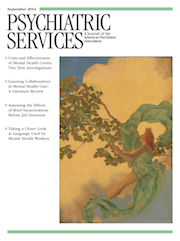To the Editor: We read with great interest the article by Simon and colleagues in the December 2013 issue about the ability of the Patient Health Questionnaire (PHQ-9) to predict a suicide attempt or suicide death (
1). The authors recommended proactive steps similar to those we recently employed as part of a large epidemiological study that included the PHQ-9.
Beginning in 2012, the U.S. Department of Veterans Affairs (VA) launched the Follow-up Study of a National Cohort of Gulf War and Gulf Era Veterans, a longitudinal study of a panel of veterans (N=28,374). All efforts described below were approved by the institutional review board of the Washington, D.C., VA Medical Center. Survey materials provided information about the Veterans Crisis Line to all participants. Between August 2012 and September 2013, 14,254 veterans responded to the survey; 1,564 acknowledged suicidal ideation on the PHQ-9 and were referred for a telephone follow-up by a study-affiliated clinician. Referrals were provided in real time throughout the data collection period.
During follow-up calls, VA mental health clinicians assessed veterans for current suicidal ideation and in some cases provided resources, such as contact information for the Veterans Crisis Line or other VA services. If the initial call was unsuccessful in making contact, a discreet voice mail message was left that provided only contact information for the clinician and requested a return call. If a second call was unsuccessful, a discreet e-mail from a clinician was sent to those who had provided an e-mail address. The e-mail requested a return call for “important follow-up information” but did not identify the clinician’s discipline or reason for outreach. A vast majority of veterans expressed satisfaction or surprise on receiving a call, and many thanked the clinician for taking this additional step.
Clinicians eventually reached 1,197 (77%) of the 1,564 veterans. Of these, 44 (4%) were transferred directly to the Veterans Crisis Line because the clinicians determined that they were at high risk. During the transfer, the veteran was connected directly to a VA suicide prevention specialist. After the transfer, in accordance with VA protocol, Crisis Line staff alerted the veteran’s local medical center for follow-up if indicated.
Although active mental health outreach is not a common practice in survey research, it is likely supported by Simon and colleagues’ findings (
1). PHQ-9 responses may provide a window of opportunity for mental health interventions with patients or survey participants. Researchers should provide survey participants with information on accessing services and enlist the support of mental health clinicians to provide outreach when indicated. In addition to resources in many communities, there is a U.S. network of suicide prevention crisis lines, including the National Suicide Prevention Lifeline (
2). Simon and colleagues cited the temporal relationship between PHQ-9 completion and a suicide attempt or suicide death, supporting longitudinal engagement in mental health care. Even a brief clinical outreach integrated into a research study may offer a significant benefit for participants. We suggest that future research should determine whether estimates of suicide risk are comparable in samples drawn from the general population and in those drawn from clinical populations.
Acknowledgments and disclosures
The authors acknowledge the veterans who responded to the survey and Steven Coughlin, Ph.D., for contributions to the protocol.
The authors report no competing interests.

